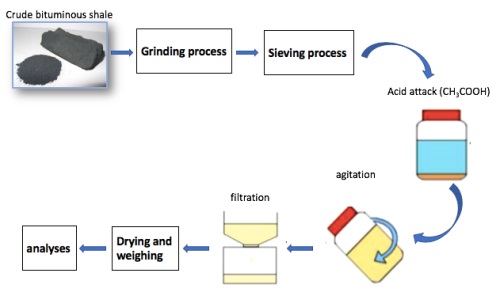
Applying Response Surface Methodology to optimize the decarbonization process of Timahdit oil shale
Abstract
The present article aims to optimize the decarbonization of Timahdit oil shale layer Y by removing carbonates from the raw rock using acetic acid. The response surface methodology “central composite design (CCD)†has been used as a method of optimization to study the 3 factors of the process. The factors studied are the concentration of the acid, the processing time, and the ratio (liquid/solid). The optimal conditions with 68.17% of residue rate are obtained with 2 mol/l as concentration, 120 min as a time of treatment and 10.02 for the ratio.
The raw (Y) and optimized materials (YO) were characterized by Scanning Electron Microscopy (SEM), X-ray fluorescence (XRF) and X-ray diffraction (XRD). The results showed that the acetic acid used to remove carbonates affects the chemical composition and the texture evolution of the residues.
Full Text:
PDFReferences
- H. Zhang, Z. Wang, J. He, E. Liu, W. Song, and S. Li, Staged condensation of oil shale pyrolysis volatiles for preliminary dedust and fractionation of shale oil, J Anal Appl Pyrol, 2019, 139, 301-307.
- S. Zendehboudi, and A. Bahadori, Shale Oil and Gas Handbook, Shale Oil, 2017, 193-230.
- A. Reva, and A. Blinderman, Underground gasification of oil shale, Underground Coal Gasification and Combustion, 2018,
-579.
- R. Bouchta, Valorization studies of the Moroccan [sic] oil shales. Office Nationale de Researches et Exploitations Petrolieres, 1984, 28.
- A. Abourriche, A. Adil, M. Oumam, H. Hannache, R. Pailler, R. Naslain, and J.P. Pillot, New pitches with very significant maturation degree obtained by supercritical extraction of Moroccan oil shales, J Supercrit Fluid. 2008, 47, 195-199.
- H. Zhan, M. Chen, K. Zhao, Y. Li, X. Miao,
H. Ye, and W. Yue, The mechanism of the terahertz spectroscopy for oil shale detection, Energy, 2018, 161, 46-51.
- V.R. Bansal, R. Kumar, M.I.S. Sastry, R.M. Badhe, G.S. Kapur, and D. Saxena, Direct estimation of shale oil potential by the structural insight of Indian origin kerogen, Fuel, 2019, 241, 410-416.
- C. Liang, Z.X. Jiang, Y.C. Cao, J. Wu, Y.S. Wang, and F. Hao, Sedimentary characteristics and origin of lacustrine organic-rich shales in the salinized Eocene Dongying Depression, GSA Bulletin, 2018, 130: 154-174.
-J. Li, S. Lu, L. Xie, J. Zhang, H. Xue, P. Zhang, and S. Tian, Modeling of hydrocarbon adsorption on continental oil shale: A case study on n -alkane, Fuel, 2017, 206, 603-613.
- M. Thomas, T. Partridge, B.H. Harthorn, and
N. Pidgeon, Deliberating the perceived risks. benefits and societal implications of shale gas and oil extraction by hydraulic fracturing in the US and UK, Nature Energy, 2017, 2, 17054.
- L. Chen, L. Zuo, Z. Jiang, S. Jiang, K. Liu,
J. Tan, and L. Zhang, Mechanisms of shale gas adsorption: Evidence from thermodynamics and kinetics study of methane adsorption on shale, Chem Eng J, 2018.
- Y.P. Huang, C.H. Hou, H.C. His, and J.W. Wu, Optimization of highly microporous activated carbon preparation from Moso bamboo using central composite design approach, J Taiwan Inst Chem E, 2015, 50, 266-275.
- R. Kumar, N. Singh, K. Kumar, N. Bishnoi, and R. Bishnoi, Response surface methodology approach for optimization of biosorption process for removal of Cr(VI) Ni (II) and Zn (II) ions by immobilized bacterial biomass sp Bacillus brevis, Chem Eng J, 2009, 146,
-407.
- O. Martins, Omorogie, B. Eliazer, Naidoo, and E. Augustine, Ofomaja, Response surface methodology. central composite design process methodology and characterization of pyrolyzed KOH pretreated environmental biomass: mathematical modeling and optimization approach, Modeling Earth Systems and Environment, 2017, 3, 1171-1186.
- B. Sadhukhan, K. Mondal, and S. Chattoraj, Optimisation using the central composite design (CCD) and the desirability function for sorption of methylene blue from aqueous solution onto Lemna major, Karbala International Journal of Modern Science, 2016, 145-155.
- M. Ghaedi, and S.N. Kokhdan, Removal of methylene blue from aqueous solution by wood millet carbon optimization using response surface methodology, Spectrochimica Acta Part A: Molecular and Biomolecular Spectroscopy, 2015, 136-141.
- M. Tarbaoui, M. Oumam, N. Fakhfakh, B.El Amraoui, M.Benzina, A. Bennamara, M. Charrouf, and A. Abourriche, Optimization of conditions for the preparation of new adsorbent material from residues of marine sponges using experimental design method, Anal Chem, 2015 15, 054-064.
- S.K. Behera, H. Meena, S. Chakraborty, and B.C. Meikap, Application of response surface methodology (RSM) for optimization of leaching parameters for ash reduction from low-grade coal, Int J Mining Sci and Tech, 2018, 28, 621-629.
- M. Tuzen, A. Sarı, and T.A. Saleh, Response surface optimization kinetic and thermodynamic studies for effective removal of rhodamine B by magnetic AC/CeO2 nanocomposite, J Environ Manage, 2018, 206, 170-177.
- R.H. Myers, D.C. Montgomery, and C. Anderson-Cook, Response Surface Methodology: Process and Product Optimization Using Designed Experiments. Wiley S Pro, 2015, 704.
-A.I. Khuri, S. Mukhopadhyay, Response surface methodology, Wires Comput Stat, 2010.
- S. Chattoraj, N.K. Mondal, B. Das, P. Roy, B. Sadhukhan, Biosorption of carbaryl from aqueous solution onto Pistia stratiotes biomass, Applied Water Science, 2014, 4, 79-88.
- S. Senthilkumaar, P. Kalaamani, and C.V. Subburaam, Liquid-phase adsorption of Crystal violet onto activated carbons derived from male flowers of the coconut tree, J Hazard Mater, 2006, 136, 800-808.
- P. Saha, S. Chowdhury, S. Gupta, I. Kumar, R. Kumar, Assessment on the removal of malachite green using tamarind fruit shell as biosorbent, Clean Soil Air Water, 2010, 38, 437-445.
- A. Gadhe, S.S. Sonawane, M.N. Varma, Optimization of conditions for hydrogen production from complex dairy wastewater by anaerobic sludge using desirability function approach, Int J Hydrogen Energ, 2013, 38, 6607-6617.
- F. Divsar, K. Habibzadeh, and S. Shariati, Aptamer-conjugated silver nanoparticles for the colorimetric detection of arsenic ions using response surface methodology. Anal. Methods, 2015, 7(11), 4568-4576.
- MA. Bezerra, RE. Santelli, and EP. Oliveira, Response surface methodology (RSM) as a tool for optimization in analytical chemistry. Talanta, 2008, 76(5), 965- 977.
DOI: http://dx.doi.org/10.13171/mjc851907027lm
Refbacks
- There are currently no refbacks.
Copyright (c) 2019 Mediterranean Journal of Chemistry
